Rehabilitation and training
In 1913 Arthur Pearson (1866-1921), a newspaper proprietor who had founded the publishing company Pearsons (which published the Daily Mirror and the magazine Tit Bits, and later acquired the Evening Standard), had been told by an Austrian specialist that he would be blind in less than a year from glaucoma. Undaunted, he told his wife that he would never be 'a' blind man, he would be 'the' blind man.
In blindness Pearson worked for the National Institute for the Blind, joining its Council in October 1913 and becoming its Treasurer in January 1914. He recognised that a blind man, above all, needed an occupation and he imagined a hostel where blindness would be regarded as a handicap to be overcome, not an affliction to be borne.
August 1914 saw the outbreak of WW1, and the first blinded soldier of the war was a Belgian, brought to a military hospital in England. His plight came to the knowledge of Pearson at the same time that he heard of three British soldiers. He had conceived the idea of establishing a hostel to teach blinded servicemen to "learn to be blind". His ideal hostel would be a "place with plenty of room to move about and with large and beautiful grounds".
The American financier Otto Kahn (1867-1934) offered the use of his house in Regent's Park, St Dunstan's Lodge. The Lodge, with its 15 acres of grounds, was placed at the disposal of the Blinded Soldiers' and Sailors' Care Committee, of which Pearson was Chairman. While the Lodge was made ready for its new occupants, the Committee opened the Blinded Soldiers and Sailors Hostel at 6 Bayswater Hill, a property lent by Mrs Lewis Hall. Opened in February 1915,with accommodation for 14 residents. it was soon outgrown by the number of blinded men.
The Hostel moved to its new location on 26th March 1915. Established as a charity and maintained jointly by the British Red Cross Society, the Order of St John of Jerusalem and the National Institute for the Blind, and supported by public donations, it was renamed St Dunstan's Hostel for Blinded Soldiers and Sailors. The ballroom of the house was used as a lounge and the large conservatory became a workshop. By May 1915 there were 30 residents, of whom 3 were Belgian and 2 were officers, both Irishmen. The nursing staff consisted of a Matron and a trained nurse. Several orderlies and 8 members of Voluntary Aid Detachments did the housework. An orderly slept in each of the dormitories, and the nurse's room was on the same floor.
Staff from St Dunstan's visited newly blinded servicemen at the 2nd London General Hospital or, if that was full, the 3rd London General Hospital, to reassure them that they would be supported and trained to lead a normal life at the Hostel, once their injuries had healed.
By March 1916 the Hostel had 150 residents. In July Pearson was knighted for his services to the blind, and took the title Pearson, 1st Baronet of St Dunstan's. By October 1916 the influx of casualties had grown at an alarming rate and the nearby Regent's Park College (Holford House) was temporarily loaned to St Dunstan's for use as accommodation for 200 men. The National Institute for the Blind agreed to establish an After Care Branch to support the ex-servicemen once their period of training was finished.
After its first year of operation, 51 men had been resettled back in their own homes and workshops. They had received training in boot-repairing, mat-making, net-making, basket-making, joinery, poultry farming and market gardening. One had qualified as a masseur (physiotherapist).
The men were also given training in Braille and typewriting, telephony and Braille shorthand. Many of the instructors were themselves blind. All kinds of sport were encouraged - athletics, tug-of-war, rowing (an arm of the lake in Regent's Park ran into the grounds), swimming, calisthenics and even goal-shooting against professional goalkeepers from famous football clubs, such as Arsenal. Entertainments, concerts and twice-weekly dances were held. Residents were encouraged to learn a musical instrument, and the Hostel had its own band.
Annexes for St Dunstan's opened at Blackheath in southeast London, Brighton, Torquay, and other large towns. In 1918 West House in Brighton was presented to St Dunstan's by the Federation of Grocers' Associations. (West House was renamed Pearson House in 1957. It was sold in 1995).
After the war the Hostel continued to provide training and support for some 1,500 blinded ex-servicemen.
At the end of 1920 Otto Kahn informed Sir Arthur that he wished to have St Dunstan's Lodge returned.
The National Institute for the Blind obtained a lease for St John's Lodge, another mansion house in Regent's Park, built in 1818 for the 3rd Marquess of Bute, which had been Sir John Ellerman's Hospital for disabled officers.
In 1921 St Dunstan's relocated its workshops and classrooms to the new location. By now it had nearly 2,000 men, either in training or being supported by the After Care Branch.
In December Sir Arthur died in an accident, and a young war-blinded officer, Ian Fraser (1897-1974), took over as Chairman, just as the national economic slump began. A series of economies had to be made to enable St Dunstan's to continue its services to the war blind, and several country annexes had to close. To maintain employment, the Hostel set up an Employment Bureau for men trained as telephonists and stenographers. A massage and electrotherapeutic clinic was established at 18 Christopher Street in Finsbury Square, employing one sighted masseur and a number of blind ones.
Some 200 of St Dunstan's residents became poultry farmers, at first at Dollis Hill and later at Kings Langley in Hertfordshire. 130 trained as masseurs and were initially employed in the military hospitals, but faced problems as these began to close down after the war. Six percent were trained as homecraft workers. The most successful resettlement was in telephony. A great deal of the Hostel's income was spent on establishing and equipping workshops for its trained men in their own home areas; this was seen as preferable to letting them try - and fail - to find their own places, and thus to fall into unemployment. On leaving St Dunstan's each man was presented with a wireless set (radio).
A special blind man's watch was supplied by the National Institute for the Blind for the residents of St Dunstan's. It was large in size and its face was covered. When a spring above the winder was pressed, the cover opened and disclosed the time - marked by raised dots on the dial. Inexpensive and easy to use, these watches assisted the men to lead a normal life.
In 1934 the Hostel was still looking after 2,000 ex-servicemen in one way or another. Nineteen new cases had been admitted the previous year, including five mustard gas cases, the pernicious effects of which had been delayed for 15 years. While the headquarters remained at St John's Lodge, 'bed' cases were sent to West House in Brighton.
By the mid 1930s West House had become inadequate for the numbers needing holidays or periods of convalescence. With the prospect looming of another war with Germany, a site for a new building was found at Ovingdean, just outside Brighton. The new 6-storey building of steel and brick was designed internally for blind occupants, with simplicity of layout, guide rails, rubber-edged doors and safety gates on stairways. It had 130 beds. Planned in 1935, it opened in 1938. (Originally named St Dunstan's Ovingdean, it was renamed Ian Fraser House in 1971, but reverted to its original name in 1995). The workshops and classrooms moved from London to Brighton and Ovingdean.
During WW2 it was considered too dangerous for St Dunstan's to remain on the South Coast and, in 1940, the War Office offered requisitioned buildings at Church Stretton in Shropshire. West House and St Dunstan's Ovingdean were evacuated there (returning in 1946). The headquarters had remained at St John's Lodge, and the building received some bomb damage; the recording studio for the production of 'talking books' was destroyed.
The charity for blinded soldiers, sailors and airmen now simply called itself "St Dunstan's".
St Dunstan's helped blinded prisoners-of-war in Germany, via the British Red Cross (the only organisation allowed to keep in touch with enemy prison camps), advising on what blinded prisoners needed most - correspondence courses in Braille, books printed in Braille, special dominoes and playing cards, and eye-shades and eyedrops for those recovering from blindness.In 1948 St Dunstan's headquarters moved to 191 Old Marylebone Road, which had been vacated by Queen Charlotte's Hospital.
Present status (April 2009)
A fire in the 1930s destroyed St Dunstan's Lodge. It was demolished in 1937 and a new villa, Winfield House, was built on the site for Barbara Hutton, daughter of the founder of Woolworths. When her marriage to the actor Cary Grant was dissolved in 1946, the mansion was presented to the United States government for use as the American Ambassador's residence. It remains so to this day.
St John's Lodge is one of the two original surviving villas in Regent's Park planned by John Nash during the 19th century (the other is The Holme). The Lodge is Grade-II listed and is currently owned by Prince Jefri, brother of the Sultan of Brunei.
In 1984 St Dunstan's headquarters moved again, to 12-14 Harcourt Street, once the site of Queen Charlotte's Hospital Infant Consultation Centre.
Update: October 2012
St Dunstan's has now been renamed Blind
Veterans UK.
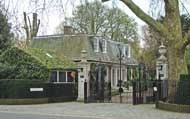
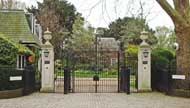
The Lodge and entrance to Winfield House, once the site of St Dunstan's Lodge.
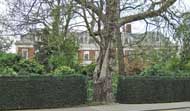

The north side of Winfield House is barely visible through the trees in the Outer Circle, Regent's Park.
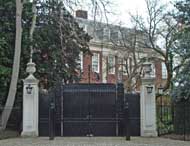
The exit gateway on the south of the site.

The east end of St John's Lodge on the Inner Circle, Regent's Park, as seen from the public gardens. The Lodge housed St Dunstan's workshops from 1921 to 1937.
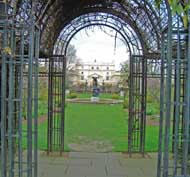
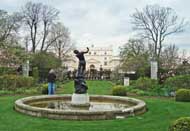
Entering the public gardens (left), St John's Lodge can be seen in the distance (right).
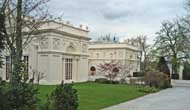
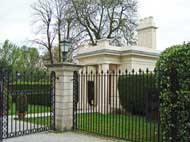
The entrance lodges and gateway.
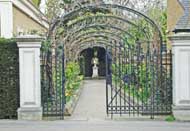

The public entrance to gardens (left) and a garden explainer (right).
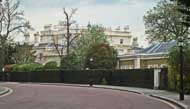
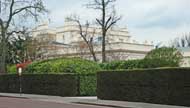
The Lodge as seen on the Inner Circle approaching from the east.
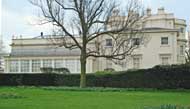
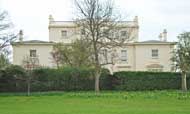
The northern elevation (left) and the western (right).
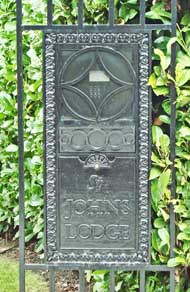
The Lodge name plate.
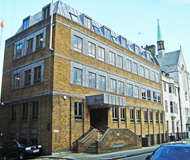
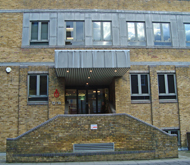
The site of the Infant Consultation Centre in Harcourt Street is now the headquarters for St Dunstan's.
In 1935 the clock was restored to St Dunstan's-in-the-West by the press baron Lord Rothermere, ostensibly to mark the Jubilee of King George V.
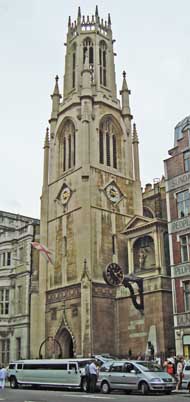
St Dunstan's-in-the-West, 186a Fleet Street, EC4A 2HR
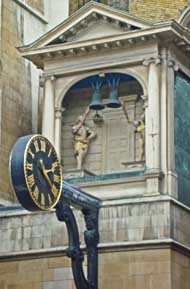
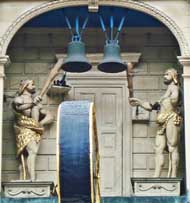
The clock which used to be located in Regent's Park (left). Two giants holding clubs strike the hour (right).
St Dunstan was not the patron saint of the blind (that was St Lucy of Syracuse), but the patron saint of goldsmiths, jewellers and locksmiths.
(Author unstated) 1915 St Dunstan's Lodge, Regents Park, N.W. The Blinded Soldiers' and Sailors' Hostel. British Journal of Nursing 1st May, 372-374.
(Author unstated) 1917 Learning to be blind. British Journal of Nursing 15th December, 394.
(Author unstated) 1918 The welfare of blinded soldiers and sailors. British Journal of Ophthalmology 2, 491-493.
(Author unstated) 1921 Editorial. 'Victory over blindness'. British Journal of Nursing 14th July, 33.
(Author unstated) 1934 St Dunstan's. British Medical Journal 1 (3820), 541.
(Author unstated) 1934 (Untitled). British Medical Journal 2 (3852), 828.
(Author unstated) 1936 St Dunstan's. British Medical Journal 2 (3964), 1331.
(Author unstated) 1940 A blow at the blind. British Journal of Nursing, December, 207.
(Author unstated) 1941 St Dunstan's helps blind prisoners. British Journal of Nursing, September, 151.
(Author unstated) 1944 Help for St Dunstan's. British Journal of Nursing, January, 7.
(Author unstated) 1975 St Dunstan's. A Story of Accomplishment. London, St Dunstan's.
Pearson A 1919 Victory Over Blindness. New York, George H. Doran.
Rawlinson JH 1919 Through St Dunstan's to Light. Toronto, Thomas Allen.
http://newspapers.nl.sg
http://query.nytimes.com (May 1915)
http://query.nytimes.com (February 1919)
http://trove.nla.gov.au (June 1916)
http://trove.nla.gov.au (December 1920)
http://trove.nla.gov.au (July 1922)
www.britishpathe.com
www.castlehillsberwick.com
www.gardenvisit.com
www.gilliesarchives.org.uk
www.inter-disciplinary.net
www.london-olympics-information.org.uk
www.medicinae.org
www.royalparks.org.uk
www.unz.org
www.worldwar1postcards.com
Return to home page